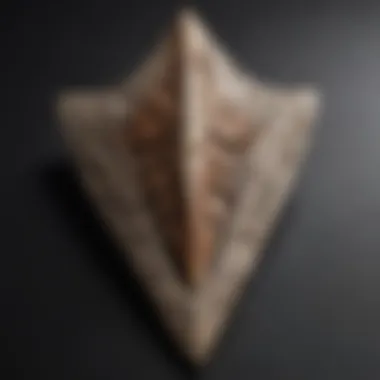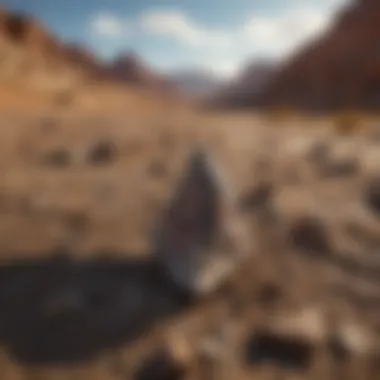Authentic Arrowheads for Sale: A Complete Guide


Intro
The allure of authentic arrowheads captivates collectors and enthusiasts alike. These artifacts offer a window into the past, revealing the skills and culture of ancient peoples who crafted them. Understanding their historical and cultural significance is foundational for anyone interested in acquiring such items. Beyond the aesthetic appeal, the pursuit of arrowheads comes with the responsibility of ensuring authenticity and ethical considerations in collection.
This guide serves as a valuable resource for those looking to deepen their understanding of authentic arrowheads, from their origins to their preservation. The insights presented will help both seasoned collectors and newcomers navigate the landscape of arrowhead collecting effectively.
Rock and Fossil Identification
Recognizing genuine arrowheads requires knowledge about the materials used in their construction. Arrowheads are typically made from various rocks, including flint, obsidian, and other sedimentary stones. Knowing how to identify these materials can greatly aid in determining authenticity.
Types of Rocks and Fossils
Arrowheads are usually crafted from:
- Flint: A hard, sedimentary form of rock, known for its sharp edge.
- Obsidian: A naturally occurring volcanic glass that can be incredibly sharp.
- Chert: Another sedimentary rock, often banded and can appear in various colors.
These rocks vary significantly in appearance and properties. Some possess unique markings or colors that can pinpoint their origins, which adds to their value and collectability.
Characteristics to Look For
When examining arrowheads, collectors should consider:
- Color and Texture: Each rock type has distinct variations in color and texture.
- Edge Work: Authentic arrowheads often display precise flaking patterns and edge configurations, which indicate skilled craftsmanship.
- Patina: Over time, authentic arrowheads develop a natural patina that synthetic replicas typically lack.
Tools for Identification
To accurately identify authentic arrowheads, collectors may use:
- Hand Lenses: Help examine textures and surfaces closely.
- Geological Hammers: Useful for testing the rock's durability and sound.
- Field Guides: Reference materials that can assist in identifying local rock types and characteristics.
"The key to authenticity lies beneath the surface. A keen eye and the right tools can separate fact from imitation."
Collecting Tips and Techniques
When it comes to collecting arrowheads, preparation and strategy are crucial. Here are some effective tips for assembling a collection.
Best Practices for Collecting
Adopt an informed approach to collecting by:
- Researching Local Laws: Know what is legal to collect in your area to avoid penalties.
- Documenting Finds: Keep a log of where each arrowhead was found, including its location and date.
- Networking with Other Collectors: Join forums or local clubs to exchange tips and finds.
Locating Prime Collecting Sites
Prime locations for finding arrowheads often include:
- Riverbanks: Erosion can uncover hidden artifacts.
- Construction Sites: These locations may disturb ancient deposits.
- Parks and Natural Reserves: Some areas allow collection; always check regulations first.
How to Safely Extract Specimens
When extracting arrowheads:
- Use tools that minimize damage to the surrounding area.
- Be aware of your surroundings to avoid getting injured.
- Take care to preserve the context of the find, as it can contribute to its historical value.
Preservation and Display
Once collected, proper preservation of arrowheads is essential to maintain their integrity and value.
Techniques for Preserving Rocks and Fossils
Preservation techniques include:
- Cleaning: Use a soft brush with water to remove dirt without harming the surface.
- Storage: Use acid-free materials for long-term preservation, keeping items away from direct sunlight.
Proper Storage Methods
Arrowheads should ideally be stored
- in padded boxes or display cases.
- in climate-controlled areas to prevent deterioration.
Creative Display Ideas
Creative ways to display arrowheads might involve:


- Shadow boxes that highlight unique features.
- Wall mounts for showcasing craftsmanship.
- Labels that provide details about the origin and significance of each piece.
Geological Insights
Understanding the geology of arrowheads adds depth to the appreciation of these artifacts.
Geological Formations and Processes
Different geological formations influence the availability of quality materials. For instance, volcanic activity leads to the formation of obsidian, while sedimentary processes create rock formations yielding flint.
Historical Significance of Rocks and Fossils
Rocks and fossils serve as documentation of historical events, informing us about past climates and ecosystems. Collecting such items becomes a personal history lesson.
Notable Discoveries in the Field
The field of arrowhead discovery is rich with notable finds, from ancient Caddoan artifacts in Arkansas to prehistoric points found across North America. Each find contributes to a larger narrative of human history.
Collecting authentic arrowheads is not merely a hobby; it is a connection to our past. Through careful identification, ethical practices, and proper preservation, collectors can keep history alive.
Understanding Arrowheads
Understanding arrowheads is crucial for anyone interested in their history, use, and collection. Arrowheads are not merely tools; they are artifacts that reveal much about the cultures that created and used them. Each artifact carries stories from specific historical contexts, encapsulating techniques in crafting and hunting practices.
Being aware of the importance of arrowheads paves the way for deeper appreciation and informed decision-making when it comes to collecting or purchasing. Knowing their types and historical significance can prevent naive mistakes, especially when distinctions between genuine artifacts and reproductions are at stake.
Historical Significance
Arrowheads hold significant historical value, providing vital clues about the lifestyles and practices of ancient peoples. They reflect advancements in technology and skill from primitive times to present. Collectors can trace how societies adapted their tools to improve hunting efficacy, availability of materials, and interactions with their environment.
Types of Arrowheads
Stone Arrowheads
Stone arrowheads are among the most common types found in archaeological sites. Their significance lies in their primitive usage and the diverse techniques employed in their creation. Regions around the world display various styles and shapes, influenced by the local materials and cultural preferences. A key characteristic of stone arrowheads is their craftsmanship. These artifacts can reflect intricate flaking techniques, showcasing the maker's skill.
One advantage of stone arrowheads is their historical link to early human survival. However, they can be more vulnerable to damage in comparison to modern materials.
Metal Arrowheads
Metal arrowheads emerged later in history, reflecting a technological advancement over stone. Their resilience is a major benefit. Often made of materials such as iron or bronze, metal arrowheads were more effective in hunting, being less likely to break under stress. Their weight and design contributed to increased accuracy over longer distances.
However, metal artifacts may require careful cleaning and preservation. Exposure to air can lead to rust or degradation. Handling them demands appropriate methods to maintain their condition.
Composite Arrowheads
Composite arrowheads combine different materials to maximize efficiency. This includes a mix of stone for the tip and wood or other materials for the body. Their adaptability makes them a popular choice in various cultures. By blending materials, craftspeople could create highly efficient tools suited for a range of hunting conditions.
The downside to composite arrowheads is the complexity involved in crafting and repairing them. Lost or damaged components may render these artifacts less functional unless expertly restored.
Cultural Relevance
Cultural relevance tied to arrowheads suggests their continued significance in both historical studies and contemporary practices. They are markers of identity and history across generations, allowing scholars and collectors to piece together the stories of different cultures.
Indigenous Cultures
For many indigenous cultures, arrowheads are not mere artifacts but represent deep-rooted traditions. They embody hunting practices and community survival, forming a bond between past and present. The cultural identity tied to these artifacts is invaluable. Their crafting techniques are often passed down, preserving cultural knowledge and artistry.
However, these practices face challenges today. Modernization and loss of traditional skills have the potential to jeopardize authentic cultural expressions surrounding arrowhead creation.
Modern Recreational Use
In modern contexts, arrowheads serve recreational purposes as well. Various groups and enthusiasts engage in workshops, learning to create replicas using techniques similar to those of ancient peoples. This engagement promotes hands-on learning and cultural appreciation. It provides insight into historical practices and enhances understanding of the tools that shaped human civilization.
While modern recreators often focus on making replicas, it is critical to distinguish between authentic and non-authentic items for collectors. Awareness of this difference enriches the experience and keeps traditions alive.
Understanding the profound significance of arrowheads enriches collecting and discussions around cultural identities. Authentic arrowheads are more than collectibles; they are part of a long human story.
Authenticity Verification
Authenticity verification is a crucial step in the world of arrowhead collecting. Genuine artifacts can hold significant historical and monetary value. Therefore, understanding the methods to confirm authenticity is essential for collectors, sellers, and enthusiasts alike. This section outlines key aspects of recognizing genuine arrowheads, utilizing forensic methods, and leveraging resources for authentication. The benefits of verifying authenticity are manifold, including ensuring the integrity of collections and protecting against potential fraud.
Recognizing Genuine Artifacts


Material Analysis
Material analysis involves examining the physical composition of the arrowhead to determine its authenticity. This technique utilizes various scientific tools to identify the raw materials used. A key characteristic of material analysis is that it can reveal whether an artifact is made of a specific stone type, which is often unique to certain cultural periods or regions. This makes it a popular choice among collectors.
A unique feature of material analysis is its ability to distinguish natural wear and patina from artificial aging processes. By assessing these traits, collectors can ascertain the likelihood of an arrowhead being authentic. However, one limitation is that advanced testing may require specialized equipment and expertise, which could pose logistical challenges for some collectors.
Technological Considerations
Technological considerations include the tools and methodologies used to assess arrowheads. Techniques like X-ray fluorescence or portable Raman spectroscopy are invaluable for testing. A key characteristic of these methods is their non-invasive nature, allowing collectors to conduct assessments without damaging artifacts. This aspect makes them a beneficial choice for details on authenticity while preserving the item.
Technological methods have the advantage of producing quick results, which is vital in fast-paced marketplaces. However, they may sometimes require costly equipment, which could deter some collectors from utilizing them effectively.
Forensic Methods
Chemical Testing
Chemical testing involves analyzing the elemental composition of an arrowhead to verify its authenticity. This method is particularly important for ensuring that replications or forgeries are identified. A primary characteristic of chemical.testing is its precise results, which can show whether the materials align with known historical facts about genuine artifacts.
The unique feature here is the ability to detect synthetic materials disguised as authentic ones. However, it is important to note that chemical testing can be complex and may require professional assistance to interpret results adequately.
Microscopic Analysis
Microscopic analysis uses high-powered magnification to inspect arrowheads closely. This method helps identify markings, tool marks, or characteristics that indicate a piece's age or provenance. A key characteristic of this analysis is its detailed examination, which can reveal signs of usage or manufacturing techniques indicative of different cultural origins.
The advantage of microscopic analysis lies in its ability to uncover details invisible to the naked eye. However, one limitation might be the required expertise and equipment, which can make it less accessible to novice collectors.
Dating Techniques
Dating techniques are essential for establishing the timeline of an artifact's creation. These methods can involve radiocarbon dating or dendrochronology, depending on the materials involved. The critical aspect of dating techniques is their capability to provide a temporal context for arrowheads, which can significantly influence their value.
The unique feature of these techniques is their scientific basis, allowing for accurate historical assessments. However, one drawback is that these methods may not be feasible for all types of arrowheads, especially those that are entirely stone.
Resources for Authentication
Professional Appraisers
Professional appraisers offer valuable insights and services for verifying the authenticity of arrowheads. Their expertise can save collectors time and potential losses from acquiring fakes. A key characteristic of professional appraisers is their extensive knowledge, often accumulated through years of experience in archaeology or anthropology. This makes them a preferred choice for serious collectors.
The advantage of working with professional appraisers is their ability to provide certified evaluations, which can enhance the resale value of collectibles. On the downside, their services can be costly, which may not be practical for casual collectors.
Assessing Certifications
Assessing certifications is another method to ascertain authenticity. Many authentic artifacts come with certificates from recognized authorities. A key characteristic of certifications is their role in providing a reference point for collectors regarding the validity of a piece. This aspect makes them popular among buyers looking for assurance before committing to a purchase.
The unique feature of assessing certifications is that it can help buyers identify reputable sellers and minimize the risk of fraud. However, a disadvantage is that not all genuine pieces come with certifications, which might make it harder for collectors to authenticate certain artifacts.
Marketplace Overview
Understanding the marketplace for authentic arrowheads is crucial for collectors and enthusiasts. This section highlights where to buy these artifacts, factors influencing their pricing, and ethical considerations surrounding their acquisition. Knowledge of the marketplace can help individuals make informed decisions, avoiding pitfalls such as purchasing replicas instead of genuine items. It provides collectors with insights into different buying venues, guiding them to acquire pieces that will enhance their collections.
Where to Buy Authentic Arrowheads
Online Auctions
Online auctions have gained significant popularity for buying authentic arrowheads. Websites like eBay allow sellers to reach a wide audience, offering various arrowheads at different price points. Buyers can find unique pieces that may not be available in traditional stores. The key characteristic of online auctions is their dynamic nature. Bidding adds an element of excitement, but it can also lead to inflated prices. While there is a vast selection, the risk of misrepresentation exists. Thus, careful research and knowledge are necessary to ensure authenticity.
Specialized Retailers
Specialized retailers focus on artifacts and collectibles, providing a more curated selection compared to general marketplaces. Shops like The Arrowhead Store often have knowledgeable staff who can provide background on each piece. This setting fosters trust, as buyers can discuss the items directly with experts. Furthermore, specialized retailers usually offer guarantees of authenticity, giving collectors peace of mind. However, the prices may be higher than those found at auctions, reflecting the quality and assurance provided by these sellers.
Collectors' Marketplaces
Collectors' marketplaces serve as venues where enthusiasts gather to buy, sell, and trade arrowheads. Platforms like Reddit have communities where collectors share information and offer items for sale. These marketplaces offer a sense of community and shared passion. They also allow negotiation between collectors, which can lead to better deals. However, validating the authenticity of items can be challenging as there are no formal checks in place. Thus, collectors must rely on their knowledge and the community's reputation.
Pricing Dynamics
Factors Influencing Value
Several factors influence the value of arrowheads, including age, material, and provenance. Age is significant as older arrowheads usually hold more historical value. Rare materials or unique styles also command higher prices. Additionally, documented history increases an arrowhead's appeal. Buyers should be aware of these factors, as they directly influence the investment potential of their purchases. Understanding value helps collectors make calculated decisions.
Historical vs. Modern Pieces
A clear distinction exists between historical and modern arrowheads. Historical arrowheads often come from Native American cultures and have significant historical context, making them more sought after. Modern pieces, though sometimes crafted with great skill, lack the same historical significance. Collectors might prefer historical items for their rarity, while modern ones may appeal to those interested in craftsmanship. Each category serves different collector motivations, impacting their pricing in the market.


Ethical Considerations
Legal Regulations
Legal regulations play a critical role in the arrowhead market. Many countries have laws protecting cultural artifacts, which means that collecting and selling these items must comply with specific regulations. Understanding local laws is essential to avoid legal troubles. Buying arrowheads without clarity on these regulations can lead to serious consequences, including fines or confiscation of items. Ethical collecting practices ensure the preservation of cultural heritage.
Responsible Collecting Practices
Responsible collecting practices involve ensuring that the acquisition of arrowheads does not harm cultural sites or violate laws. This includes knowing the source of items and avoiding markets that offer questionable provenance. Collectors should be aware of the impact their purchases have on archaeological sites and strive to support ethical sellers. By adopting responsible practices, collectors contribute to the sustainability of the hobby and respect the cultures from which these artifacts originate.
Collectors' Insights
Understanding the world of arrowhead collecting provides important insights into the nuances of this fascinating hobby. In this section, we discuss various aspects that are critical for both new and seasoned collectors. We explore how to build a collection wisely and the value of connecting with others who share this interest. These elements contribute significantly to the enjoyment and appreciation of authentic arrowheads, enhancing both knowledge and community.
Building a Collection
Starting Points for New Collectors
Starting a collection of arrowheads can be both thrilling and daunting. New collectors should prioritize research and education about their artifacts. The key characteristic of starting here is the foundation it builds for a broader understanding of arrowheads. By studying various types, styles, and materials, collectors can discern what piques their interest. This not only makes collecting more enjoyable but also ensures more informed purchases.
One unique feature of this approach is the ability to develop a personal focus. Whether one is drawn to stone arrowheads or modern reproductions, this choice can shape their collection. The advantages include having a clear direction and minimizing the overwhelming nature of the market. However, beginning collectors must also be cautious of their budget and avoid impulse buys, which can lead to regret.
Strategies for Experienced Collectors
For collectors who have already gained some experience, strategies become more nuanced. One specific aspect involves exploring advanced sourcing techniques. This enables collectors to find rare pieces that enhance their collections. The key characteristic here is the depth of knowledge that experienced collectors possess, allowing them to navigate the market more efficiently.
This choice is beneficial because seasoned collectors can identify the authenticity and value of pieces, enabling them to invest wisely. A unique feature of this strategy is the use of networking, as it often leads to exclusive opportunities. However, it can be disadvantageous if one becomes overly competitive, which sometimes escalates prices beyond reasonable levels.
Networking with Other Collectors
Engaging with a community of fellow enthusiasts is an invaluable aspect of collecting. Forums and exhibitions present platforms for sharing knowledge and acquiring items not found on the general market.
Participating in Forums
Participating in forums allows collectors to exchange valuable insights. This engagement supports learning and keeps collectors updated on trends and best practices in the field. The key characteristic of forums is their accessibility; anyone can join and participate in discussions at any time. This makes it a popular choice for both newcomers and veterans alike.
The unique feature of forums lies in the collective knowledge of members. An advantage is the ability to ask questions and get advice directly from experienced collectors. However, relying too much on hearsay can sometimes lead to misinformation, so critical thinking is essential.
Attending Shows and Exhibitions
Attending shows and exhibitions offers a unique face-to-face experience that forums cannot replicate. This creates an environment where collectors can see items in person and network in real time. The key characteristic is the immediate access to authentic items, fostering an enjoyable and educational atmosphere.
A unique feature of shows and exhibitions is the opportunity to meet artisans and experts, providing deep insights into the crafting of arrowheads. This can be a significant advantage for expanding one's appreciation and knowledge of the artifacts. On the downside, travel and entry costs can be prohibitive, making this option less accessible to some collectors.
Collectors should always prioritize learning over merely acquiring artifacts.
By combining the act of collecting with education and community engagement, individuals can enrich their experience. Ultimately, collectors can create meaningful collections and foster connections that can last a lifetime.
Preservation Techniques
Preservation of arrowheads is crucial for maintaining their historical integrity and ensuring they remain valuable artifacts. The processes involved in preserving these items go beyond mere aesthetic appeal. Proper preservation techniques help prevent damage from environmental factors, physical handling, and general decay. Understanding how to effectively store and care for arrowheads can prolong their lifespan and enhance their value.
Proper Storage Methods
Humidity Control
Humidity control is one vital aspect of storing arrowheads. Excess moisture can lead to mold growth and deterioration of materials. By keeping the storage environment consistent, collectors can protect their arrowheads from such damage. Ideal humidity levels for storing arrowheads are generally between 35% to 50%. This range helps prevent any potential warping or degradation that can occur from excessive dampness.
Choosing humidity control options such as dehumidifiers or silica gel packets can be very effective. These products help absorb moisture and keep the storage area dry. One could argue that maintaining low humidity requires some investment, but the benefit of prolonging the lifespan of valuable artifacts outweighs the cost.
Display Practices
Display practices are another essential aspect of preservation techniques. Proper display ensures that arrowheads are showcased without risking damage. Using display cases that filter UV light can prevent fading and deterioration over time. This type of display allows collectors to appreciate their items while also safeguarding them.
Key characteristics of displays should focus on security and accessibility. Display cases should be sturdy and well-ventilated to avoid trapping moisture. However, collectors must also consider potential drawbacks of certain materials that can outgas harmful chemicals over time. Choosing the right materials for display is essential for maintaining the integrity of the artifacts.
Cleaning and Care
Safe Cleaning Methods
Safe cleaning methods are fundamental in maintaining the quality of arrowheads. Each artifact may require different approaches based on its material composition. For example, stone arrowheads can often be lightly brushed with a soft bristle brush, while metal varieties may require a damp cloth with a mild cleaning solution.
The key focus should be on gentle cleaning to avoid scratches or other damages. Collectors should avoid harsh chemicals and abrasive materials. These cleaning methods not only maintain cleanliness but also enhance the visual appeal of the arrowheads.
Avoiding Damage
Avoiding damage is essential in the long-term preservation of arrowheads. Collectors should implement best practices when handling their artifacts. For instance, always handle arrowheads with clean hands or gloves, and avoid touching the surfaces with bare fingers. The oils and other residues from skin contact can contribute to deterioration over time.
Utilizing protective storage solutions, such as cushioned cases and soft fabric wraps, can further reduce the risk of damage. The goal is to create an environment that minimizes exposure to the elements and potential mishaps that could harm the artifacts. Being proactive in preservation will yield significant benefits for any collector, ensuring the longevity and value of their collection.







